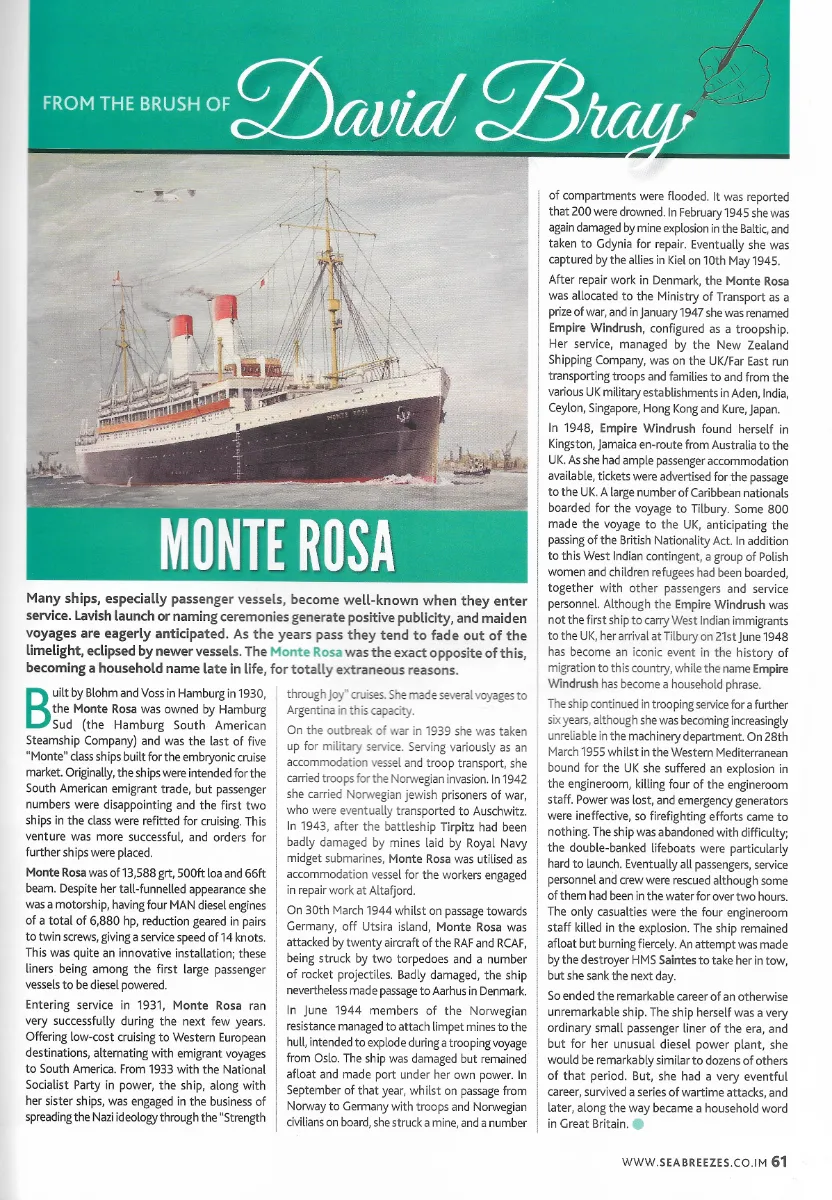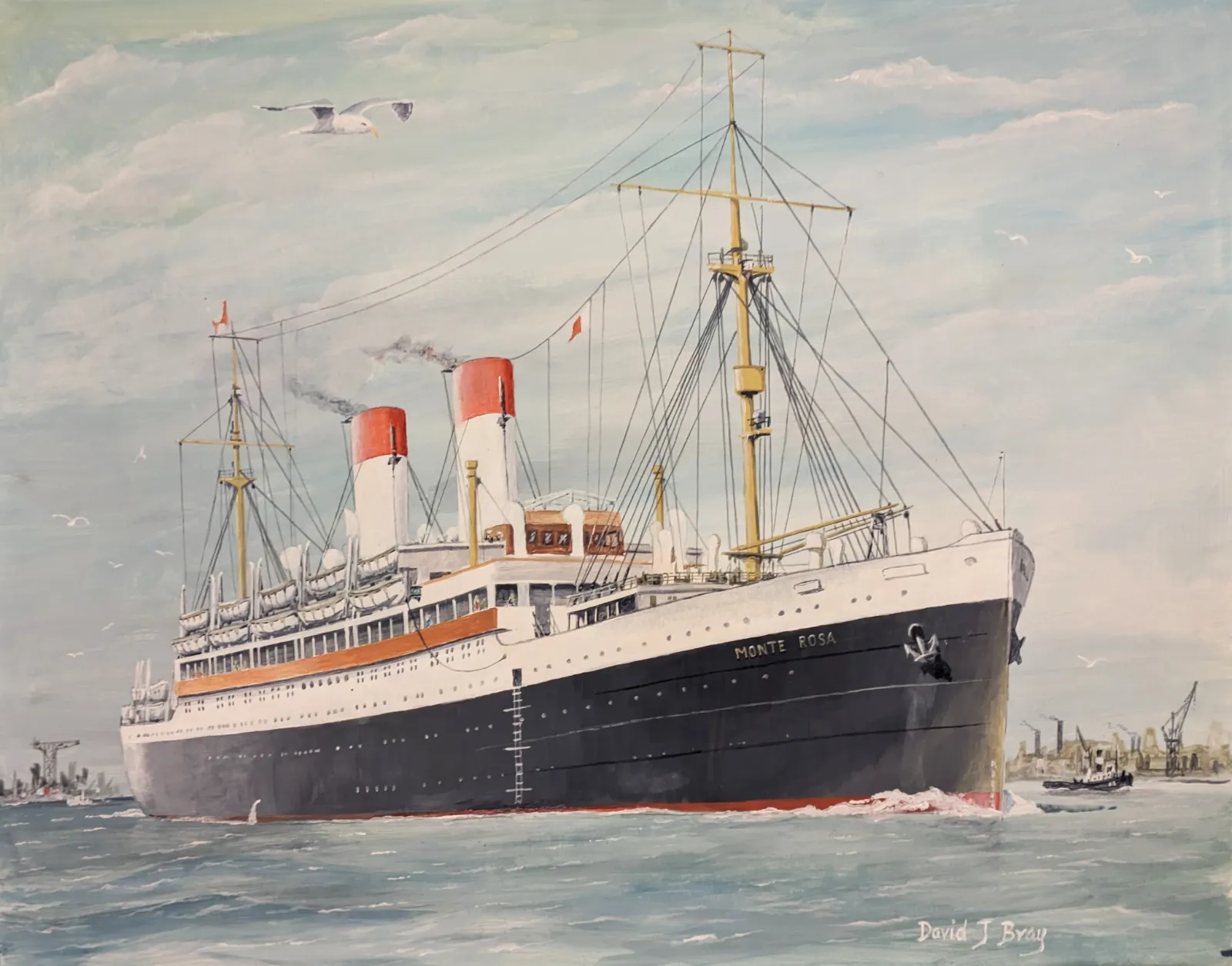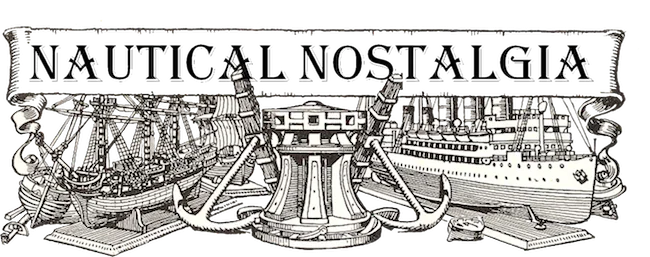From the brush of David Bray


Many ships, especially passenger vessels, become well-known when they enter service. Lavish launch or naming ceremonies generate positive publicity, and maiden voyages are eagerly anticipated. As the years pass they tend to fade out of the limelight, eclipsed by newer vessels. The “Monte Rosa” was the exact opposite of this, becoming a household name late in life, for totally extraneous reasons.
Built by Blohm and Voss in Hamburg in 1930, the “Monte Rosa” was owned by Hamburg Sud (the Hamburg South American Steamship Company) and was the last of five “Monte” class ships built for the embryonic cruise market. Originally, the ships were intended for the South American emigrant trade, but passenger numbers were disappointing and the first two ships in the class were refitted for cruising. This venture was more successful, and orders for further ships were placed.
“Monte Rosa” was of 13,588 grt, 500ft loa and 66ft beam. Despite her tall-funnelled appearance she was a motorship, having four MAN diesel engines of a total of 6,880 hp, reduction geared in pairs to twin screws, giving a service speed of 14 knots. This was quite an innovative installation; these liners being among the first large passenger vessels to be diesel powered.
Entering service in 1931, “Monte Rosa” ran very successfully during the next few years. Offering low-cost cruising to Western European destinations, alternating with emigrant voyages to South America. From 1933 with the National Socialist Party in power, the ship, along with her sister ships, was engaged in the business of spreading the Nazi ideology through the “Strength through Joy” cruises. She made several voyages to Argentina in this capacity.
On the outbreak of war in 1939 she was taken up for military service. Serving variously as an accommodation vessel and troop transport, she carried troops for the Norwegian invasion. In 1942 she carried Norwegian jewish prisoners of war, who were eventually transported to Auschwitz. In 1943, after the battleship “Tirpitz” had been badly damaged by mines laid by Royal Navy midget submarines, “Monte Rosa” was utilised as accommodation vessel for the workers engaged in repair on at Altafjord.
On 30th March 1944 whilst on passage towards Germany, off Utsira island, “Monte Rosa” was attacked by twenty aircraft of the RAF and RCAF, being struck by two torpedoes and a number of rocket projectiles. Badly damaged, the ship nevertheless made passage to Aarhus in Denmark.
In June 1944 members of the Norwegian resistance managed to attach limpet mines to the hull, intended to explode during a trooping voyage from Oslo. The ship was damaged but remained afloat and made port under her own power. In September of that year, whilst on passage from Norway to Germany with troops and Norwegian civilians on board, she struck a mine, and a number of compartments were flooded. It was reported that 200 were drowned. In February 1945 she was again damaged by mine explosion in the Baltic, and taken to Gdynia for repair. Eventually she was captured by the allies in Kiel on 10th May 1945.
After repair work in Denmark, the “Monte Rosa” was allocated to the Ministry of Transport as a prize of war, and in January 1947 she was renamed “Empire Windrush”, configured as a troopship. Her service, managed by the New Zealand Shipping Company, was on the UK/Far East run transporting troops and families to and from the various UK military establishments in Aden, India, Ceylon, Singapore, Hong Kong and Kure, Japan.
In 1948, “Empire Windrush” found herself in Kingston, Jamaica en-route from Australia to the UK. As she had ample passenger accommodation available, tickets were advertised for the passage to the UK. A large number of Caribbean nationals boarded for the voyage to Tilbury. Some 800 made the voyage to the UK, anticipating the passing of the British Nationality Act. In addition to this West Indian contingent, a group of Polish women and children refugees had been boarded, together with other passengers and service personnel. Although the “Empire Windrush” was not the first ship to carry West Indian immigrants to the UK, her arrival at Tilbury on 21st June 1948 has become an iconic event in the history of migration to this country, while the name “Empire Windrush” has become a household phrase.
The ship continued in trooping service for a further six years, although she was becoming increasingly unreliable in the machinery department. On 28th March 1955 whilst in the Western Mediterranean bound for the UK she suffered an explosion in the engineroom, killing four of the engineroom staff. Power was lost, and emergency generators were ineffective, so firefighting efforts came to nothing. The ship was abandoned with difficulty; the double-banked lifeboats were particularly hard to launch. Eventually all passengers, service personnel and crew were rescued although some of them had been in the water for over two hours. The only casualties were the four engineroom staff killed in the explosion. The ship remained afloat but burning fiercely. An attempt was made by the destroyer HMS “Saintes” to take her in tow, but she sank the next day.
So ended the remarkable career of an otherwise unremarkable ship. The ship herself was a very ordinary small passenger liner of the era, and but for her unusual diesel power plant, she would be remarkably similar to dozens of others of that period. But, she had a very eventful career, survived a series of wartime attacks, and later, along the way became a household word in Great Britain.
This article, and others, follow a series which Sea Breezes magazine is publishing, featuring David’s paintings, and the stories behind them.
